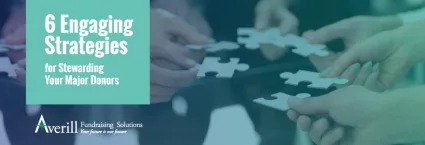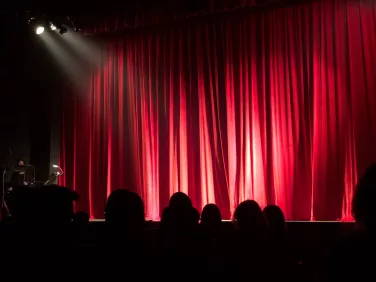
Major gifts – significant monetary contributions from donors or sponsors – play a critical role in any nonprofit’s development plan. While they are relatively rare, their impact is substantial, providing essential support for key initiatives. Securing these transformative gifts doesn’t just happen and requires more than luck; it demands a well-structured strategic plan. Nonprofits must prioritize thoughtful stewardship, targeted outreach, and strategic cultivation as core elements of their major gifts programs.
Let’s review the essential steps and best practices of a successful university or nonprofit major gifts program.

What We’ll Cover
- Step 1: Determine the Threshold for a Major Gift
- Step 2: Prepare Marketing Collateral and Documents
- Step 3: Set Up Incentives for Major Gift Donors
- Step 4: Find Your Major Gifts Prospects
- Step 5: Define the Protocol to Ask for and Receive Major Gifts
- The Fundraising Ask
- What Happens When a Donor Says Yes?
- Priorities for a Successful Major Gifts Program
- The End Goal is the Starting Point
- Establishing Donation Tiers
- Understanding Major Gift Donation Behavior
- Understanding the Dynamics of the Ask
- Understand the Possible Outcomes (Other Than the Perfect Yes!)
- Developing a Long-Term Loyal Supporter
Step 1: Determine the Threshold for a Major Gift
Major gifts are defined as significant monetary donations received from donors or sponsors. But what exactly qualifies as major? The amount can vary widely from organization to organization. The range can begin as low as $1,000 for small or new organizations and exceed $10,000 or even $100,000 for Universities or large established organizations. Determining your major gift minimum threshold depends on several factors:
- Past Donors: A good place to begin is to review your organization’s past donors and highest donation amounts received. If you have a recurring donation campaign or membership program, review these donors especially. This information can serve as a good starting threshold and help determine your major gift fundraising goal.
- Annual Fundraising Goal: Using your organization’s annual fundraising budget or goal is another point of analysis that can help determine how many major donors are needed and the amount needed for each major gift to accomplish a significant portion of the goal. Remember these donations are rare, so fundraising events, grants, and smaller donations will still likely make up the majority of your fundraising.
- Connections and Time Commitment of the Committee: After discussing the prior two points, it’s also important to evaluate your committee or Development Department’s realistic capacity to perform the outreach required for major gift donors. We’ll cover this more in detail in the section on Finding New Prospects.
Step 2: Prepare Marketing Collateral and Documents
While most major gift donations will come through warm connections and building relationships, having the proper marketing collateral reinforces your organization’s reputation. Be sure to focus on the programs and options where donors can allocate major gifts. Some donors may be happy to simply write a $20,000 check, but most major gifts donors will want to know exactly how their funds will be used and what impact or outcomes can be expected.
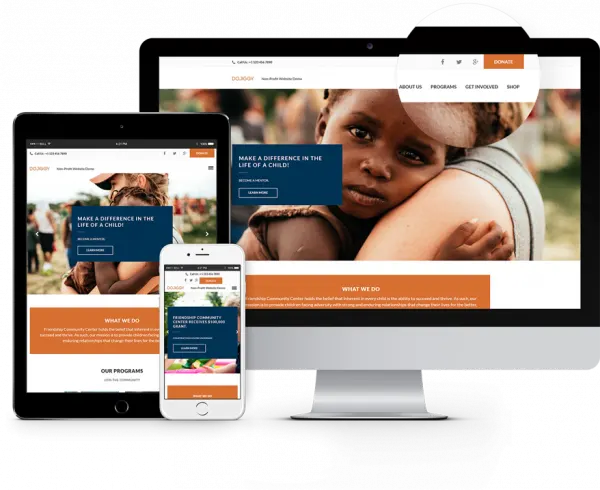
Proper marketing collateral includes the following:
- Professional Website: The organization’s website should be easy to navigate, simple but beautifully designed, and able to receive donations securely. Here is a great article to help you understand the essential elements that create an impressive nonprofit website design.
- Educational Brochures: Brochures should be available that educate supporters and donors about your organization and charitable cause, as well as your organization’s achievements to date and how their financial support helps.
- Letterhead: Any handwritten or typed letters should be completed on the organization’s professional letterhead.
- Sponsorship Collateral: Major donors like to be recognized for their generosity. Preparing a chart that illustrates your donation tiers and the incentives donors receive for donating at these incremental tiers is vital to your program’s success.
Step 3: Set Up Incentives for Major Gift Donors

Major gift donors support your organization due to your work and charitable cause, but incentives can help seal their support. The more a sponsor donates, the greater the incentives they should receive. Here are examples of incentives that are appropriate for donors of major gifts:
- Brand Recognition Opportunities: Many sponsors, especially businesses, are enticed by brand recognition opportunities. Incentives can include the business logo or individual’s name on event flyers. If there is a step-and-repeat banner for photo opportunities, their logo can be included on the backdrop for media exposure. For a non-event affiliated branding opportunity, a certain program, room or building can be named after the donor. This works especially well for alumni fundraising campaigns.
- Speaking Sessions: If your organization has an upcoming event, such as a gala or speaking panel, major donors can be offered the opportunity to present an award or introduce a keynote speaker. This serves to recognize their contributions and tie them more closely to your organization’s platform.
- Special Major Gift Events: A great way to thank major gift donors is to host an exclusive special event or give them VIP passes to a fundraising event. Special major donor events could be brunch or dinner with tickets to an event or a special tour of your organization’s work. If your organization hosts an annual charity golf outing, offer donors a foursome and VIP dinner table.
Step 4: Find Your Major Gifts Prospects
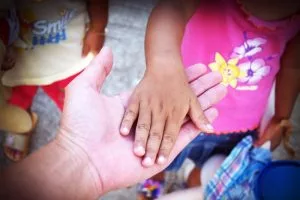
Achieving your fundraising goal requires a strong team with a realistic plan, but you also need the right tools to succeed. Nonprofit CRM and donor management software is essential to identifying and working with major gift prospects.
Major donors can be broken down into two groups:
- Already Existing Prospects: Review your past donors and see who has either consistently donated or who has donated large amounts. Approaching pre-existing donors should be warm, consistent, and informal since they already know about your cause. If a new campaign is coming up or a major gift program has been launched, assign it to a committee member or board member with a close connection to the prospect. Have them initiate a conversation to discuss the benefits of participating as a major gift donor.
- Finding New Prospects: New prospects will take a lot more effort because there is a process of gaining trust and building brand recognition for your organization. Designate certain committee members or board members certain prospects for outreach based on their connections, time capacity, and reputation.
Finding New Prospects
There are different places to find new prospects:
- Networking Groups: Whether it is a Meetup geared towards nonprofits, a technology event, a referral networking group, or otherwise, these are great places to find volunteers and donors.
- Vetting the Network of the Network: Since your supporters and donors already appreciate your cause, they may be able to introduce you to other well-connected individuals and organizations who can donate major gifts or help with in-kind donations. You’ll have to ask them to introduce you.
- Research Donors of Similar Causes: Find sources that can provide details about related organizations’ major gift donors.
Step 5: Define the Protocol to Ask for and Receive Major Gifts

Your committee and Development personnel should be in sync to understand what is necessary to request and receive a major gift. Determine the deadlines for first outreach, follow-ups and finalizing donation amounts to achieve the goal during a given period (quarterly, or annually). The organization’s Treasurer or Office Manager should communicate any tax information necessary to properly give letters or tax forms to the donors to recognize their donations.
Using fundraising software that tracks major gift donors is essential for the long-term planning and growth of your major gifts program. If logging the donation information or using donation software is not already part of the procedure, research a donor-friendly donation platform that comes with helpful features to build your donor list.
Once all the prior steps have been completed, discuss the plan and establish a protocol for receiving major gifts. You must meet with your prospects in person to make an ask. You can’t ask for major gifts in a group setting or by email.
The Fundraising Ask

Once you have determined a prospect, someone will need to call them and set up a meeting. The call as well as the in-person meeting should come from the Executive Director of the organization, a Board Member, or senior Development staff (Development Director or Major Gifts Officer). When meeting with the prospect, be sure that they already know who you are and have a relationship with you. Don’t send someone who has never met a prospect or only briefly met a prospect to do a major gift ask.
If you are just starting a major gift campaign, practice the ask before you show up for a meeting. You can practice and role-play with your team. Be sure to know who is making the ask (if you go as a team).
Don’t leave it to just happen – it’s not easy to ask for a major gift for the first time. What happens when the donor requests more information or says they will think about it…And what happens if the prospect says no? Be prepared for this.
Here are more tips on mastering the fundraising ask.
What Happens When a Donor Says Yes?
When meeting with potential donors, being prepared to receive a donation is just as important. It’s understood that major gift donations are frequently done with a handshake and a check. However, having a major gift sponsorship form on hand can be useful. Here are some helpful fields that should be on the major gift sponsorship form:
- Basic Individual/Company Information
- Contact Information
- Amount Donated
- Tax Information (to take advantage of tax write-offs for donations)
- Instructions and/or Information for executing incentives (instructions on providing their logo for a banner for a major race, information about the speaker for a speaking slot during your gala)
Priorities for a Successful Major Gifts Program
Let’s delve into the minutiae of building your donor base for a successful major gifts program.

The End Goal is the Starting Point
Like all successful fundraising campaigns, major gift programs must begin with a clearly defined goal. Why is setting a fundraising goal absolutely essential when you are just starting on a major gifts journey? One analogy to understand why it’s important is to view your goals as the final destination on a long road trip. Your fundraising strategy is the map to get there in an expected time. Without written financial goals, it’s difficult to grow year-to-year and to stay on track when your committee discusses progress. In addition, your organization’s success depends on the funds raised from these efforts. Not knowing the concrete numbers your organization must raise is setting your organization up to fail. So, let’s discuss the best strategy to define your fundraising goals.
Establishing Donation Tiers
While the relationship with your organization and charitable cause will be a large part of the reason why a sponsor considers giving a major gift, incentives help seal the support. Major donors like to be recognized for their generosity, so establishing gifting tiers is important to provide that visibility. These giving tiers work into the blueprint of who to target as your prospects. For example, having the highest tier of $50,000, with the benefits and rewards include naming a program for one semester after the benefactor and a speaking part at the charity gala. The lower end of the major gifts program may be $10,000, where the benefits and rewards include naming a table at the gala and using a logo for a step-and-repeat banner at the gala. Once the major gift donation tiers have been established, then comes the planning.
Understanding Major Gift Donation Behavior
Most organizations have a much larger donor base that makes non-major gift donations. For example, if your major gift threshold is $25,000, typically, more than 60% of your donor base will make donations under this threshold. However, because their donations are incrementally less, they make up 20-50% of your organization’s fundraising goal.
If you have historical financial data, use it to plan your major gifts strategy. Let’s say this is what your donor base looks like from the prior year:
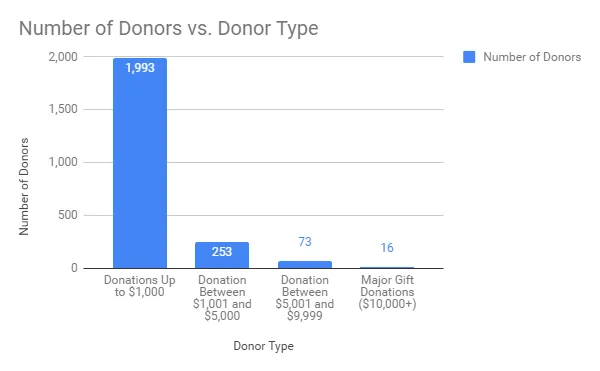
This donor behavior is a normal expectation for many nonprofit organizations. The number of donors will vary based on the size of the organization or establishment. A young grassroots group will probably look closer to these numbers, whereas a well-established university will probably have a larger donor base.
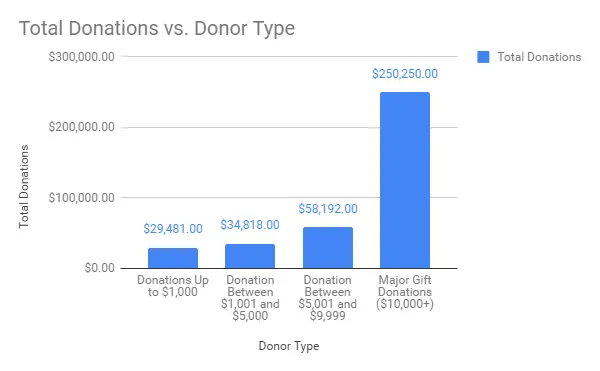
When we look at the actual dollar amount of how each tier contributes to the overall fundraising goal, we can see how vital it is to establish a definitive goal.
| Major Gift Donor Tier | Number of Donors |
| Bronze: $10,000-$14,999 | 10 |
| Silver: $15,000-$19,999 | 6 |
| Gold: $20,000+ | 3 |
By further breaking down the major gift donor base, we can build a precise goal within the types of major gift donor tiers.
Understanding data on the prior year’s performance can help bring some of the following discussions to light:
- Actual Major Gift Donors vs. Prospects: The number of actual major gift donors is 16, but how many initial prospects did the committee begin with to successfully receive these 16? The success rate can help plan for how many prospects need to be approached with an ask. Another discussion should also include understanding what tactics, sources of prospects and strategies worked.
- Returning Prospects vs. New Prospects: How many are repeat donors? How many introductions can be requested? How many new prospects are needed?
- Major Gift Fundraising Target: Each year’s fundraising target should increase to show progression and improvement of strategy and tactics, as well as demonstrate the strength of donor loyalty.
Understanding the Dynamics of the Ask
Practice makes perfect, as the saying goes. Understanding the dynamics of an ask and practicing it with your committee members is what continues to improve our nonprofit’s major gift strategy.
Remember, it’s always best to have the committee or chair member who has the closest relationship with the prospect do the ask. Here are some aspects that should be discussed in the ask, considering that some can be overlooked based on how much the prospect already knows:
Educating the Donor About the Organization
- What is the organization about?
- How has the organization affected or helped you and why do you dedicate your time, money, and effort to help them?
- New developments or ongoing programs and activities.
The Relationship Between the Donor and Organization
- Why did you specifically choose to speak with them?
- Reflecting on your relationship with them, if any.
- The Benefits and Rewards for Donation
Reinforcing a Certain Deadline
- Does a certain program launch on a certain date?
- Are there resources lacking that prevent developments?
- Is there an event planned that needs funds before a certain event milestone?
Handling the Outcome
- Prepare to receive a donation or
- Follow up with face-to-face repetition
Understand the Possible Outcomes (Other Than the Perfect Yes!)

With the previous section touching lightly upon the idea of a prospect converting into a donor, we understand that the world isn’t perfect and that not all prospects will want to donate. Here are some expected outcomes to consider:
- A Decline to Donate: The “no” is inevitable, and it’s OK because it can mean “not right now.” There are several reasons why a prospect may not want to donate. One reason would be that the prospect currently doesn’t understand the cause enough or may not be financially available at this current time to donate. In this case, not all is lost. Continue finding ways to have the prospect engaged with your organization in other ways. This may be in the form of volunteering, participating in an event, networking with other committee members in an informal setting, or otherwise.
- Agree to Donate But Not Right Now: Often, prospects don’t donate during the ask. Always plan ahead with a follow-up or the next time you’ll be speaking with the prospect to touch base. If possible, keep them engaged with the organization. Consistent follow-up is the key to many prospects becoming donors.
- Agree to Donate But Lesser Than Expected: Another reasonable outcome is not getting what was originally expected or desired. Account for this shortfall when planning your major gift program strategy.
Developing a Long-Term Loyal Supporter
Once you have won a major gift, it’s vital that you don’t take the donor for granted. Keep major gift donors continuously engaged and up-to-date with the organization’s developments, which are possible because of their support.
- Track Their Donation Activity: As we’ve recommended before, track major gift donor activity in a robust nonprofit CRM software. Always being aware of major gift donations and finding ways to reward donors throughout the year will leave a positive impression.
- Focus on Donor Retention: Always build upon the rewards and benefits of the major gifts donation program. Plan special events for donors and handwrite your thank you letters to them. Here are other great tips on the art of donor retention.
- Request Introductions: Once you have created a solid relationship and deep trust with your major gift donor, ask to be introduced to other prospective major gift donors. Always continue building the prospect list, as a pre-existing relationship and a positive reputation can be one of the lifelines to continually growing your major gift donor base.

